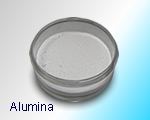Alumina (Aluminum Oxide)Outline
Outline of material propaerty - Alumina ceramics
Typical oxide-based ceramics most widely used in the industry

- Substance nameAlumina (Aluminium Oxide)
- Chemical formula Al2O3
- NotesLeft photo is white powder of alumina.
Features of Alumina ceramics
Alumina ceramics have been studied for a long time, and their manufacturing technology and product quality are stable.
Therefore, its price is low, and it is most widely used in all industrial fields.
Alumina is an oxide-based ceramic and is known as a representative. Its physical properties are particularly stable chemically, excellent in high hardness, insulation and heat resistance, and well balanced in mechanical strength at normal temperature. It is used as a cutting tool, abrasive, and other structural materials.
There are various types of alumina. 'α-Alumina' (trigonal) is the most chemically stable and is widely used for structural applications. 'γ-Alumina' has a high specific surface area (SSA) and is used as a catalyst carrier.
Chemically stable
It is resistant to most acids and alkalis, and its chemical resistance is extremely good.
High Hardness
In the Morse hardness tester, sapphire, which is a single crystal of alumina, has a hardness second only to that of diamond. (cf; Diamond: 10, Alumina: 9)
Therefore the wear resistance is also excellent.
Excellent electrical insulation
It has a high electrical property value such as volume resistivity and dielectric breakdown voltage, that is, an insulator. Even at high temperatures, it maintains insulation and is excellent in high frequency characteristics.
Good balance of mechanical properties
It is highly rigid, has high bending and compressive strength, and is suitable for processing precision parts. Therefore, it is widely used as an industrial structural component.
※ Attention point: Fracture toughness is smaller than other ceramics.
Excellent heat resistance, good thermal conductivity
It has a high thermal conductivity and is excellent in heat resistance (about 1500℃). It is also used as a refractory.
※ Attention point: The thermal expansion coefficient is high and the thermal shock resistance is weak. (Less than other ceramics)
Others
In nature, it is produced as corundum (steel ball), ruby, sapphire, etc.
Please contact us each time as there are materials that can be handled and those that do not.
The content posted on this site does not guarantee these. Please use it as reference information.

